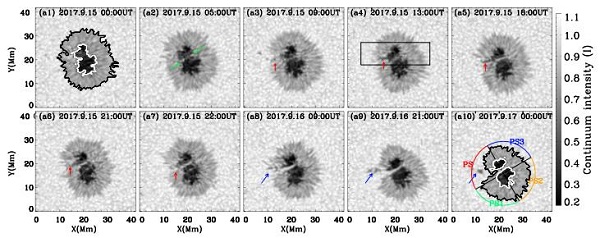Prof. YAN Xiaoli from Yunnan Observatories, Chinese Academy of Sciences (CAS) and Post-doctor LI Qiaoling from Department of Physics and Astronomy of Yunnan University studied the decay process of sunspot in AR NOAA 12680 and discussed the influence of light bridge on decaying sunspot. The results have been published recently in The Astrophysical Journal.
Prof. YAN Xiaoli and their cooperators analyzed the decay process of sunspot in AR NOAA 12680 by using the stray light calibration data from the Solar Dynamics Observatory/Helioseismic and Magnetic Imaging (SDO/HMI). The decay process of the sunspot is shown in Figure 1.
It is found that at the beginning of sunspot decay, some elongated dark structures are gradually separated from the umbra. The intensity, vertical field strength and magnetic inclination of these dark structures are between those of the umbra and penumbra. With the formation of a light bridge, the total magnetic flux of the whole penumbra region gradually decreases, and part of the penumbra located on one side of the light bridge rapidly disappears.
In addition, after the appearance of an outward motion of magnetic flux along the light bridge, the decay rate of the area and magnetic flux of the penumbral sector rapidly deceases. These results suggest that the rapid decay of the penumbral sector is correlated with the light bridge. It is suspected that the dark structure in the penumbra and the formation of light bridge may be the result of magnetic flux spreading out from the umbra, which may accelerate the decay of the sunspot.
These results can provide a reliable observation basis for the simulation study of sunspot.
This work is partially supported by the National Science Foundation of China (NSFC) ; Yunnan Key Laboratory of Solar Physics and Space Science.

Figure 1. The evolution of active region NOAA 12680 from 2017 September 15 to September 17.
Contact:
YAN Xiaoli
Yunnan Observatories, CAS
Email: yanxl@ynao.ac.cn